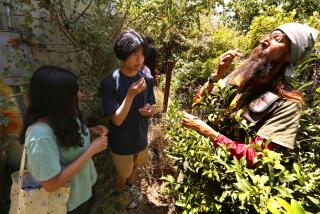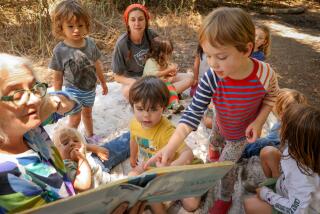Skyline Still Leads the Class in Alternative Teaching
It is both a simple and revolutionary idea: non-traditional classrooms in the public school system.
Although the idea is well-established at the Skyline School in Solana Beach, it is one that has not been championed in most school districts.
Four classrooms at Skyline are committed to an alternative education program. Children of different ages and abilities are grouped in the same classroom, studying in an environment that pays special attention to their individual interests and needs.
Parents work side by side with the teachers to keep the adult-to-pupil ratio low. Kids are encouraged to pursue learning at their own pace and may remain with the same teacher for several years.
In Linda LaGrange’s primary classroom, seven boys and girls of various ages sit at a large table. They are completing and illustrating this sentence. “Animals should definitely not wear clothing because . . .”
“They would be too long,” a small girl writes. The last child to finish prints laboriously, “Dogs can’t wear shoes,” under his drawing of a Doberman.
Nearby, a girl lies on a large piece of paper. Her outline is being traced so she can cut it out and create a life-size paper doll of herself. It will be displayed on a bulletin board with the words, “ ELLA, CHILD OF THE WEEK. “
A little boy in a wheelchair listens as another child demonstrates his Space Light Sword during Open Sharing.
The specialized program at Skyline School was created in 1978 at the urging of a group of parents who wanted an alternative to the traditional classroom without having to leave the public school system.
Interest in the program has remained strong in the dozen years it has been operating, said Berge Minasian, principal at Skyline School. This past school year, there were 96 students in the four alternative classrooms, with students from kindergarten through sixth grade. The alternative classrooms coexist at Skyline with traditional classrooms. Altogether, there are 553 students at the school.
Participation in the program is voluntary and there is a waiting list to enter the program. Within a year or so, though, interested students usually make it into the program, Minasian said. For the next school year, class assignments have been made already.
Until recently, the program accepted students from throughout North County. When the method of school funding for the district changed, enrollment was limited to residents of the Solana Beach School District--with the exception of students already in the program.
Minasian said the district, which has been recognized nationally for educational excellence, does not offer the alternative classes because it believes they are better than traditional classes, but because it believes parents and students should have choices.
The right of parents to seek alternative programs at public schools is actually guaranteed by state law. The parent or guardian of any pupil may request the governing board of a school district to establish an alternative school program, participation in which must be voluntary. If parents are interested is seeing an alternative program established, Minasian urges them to first speak with the local principal about it. Depending on what is recommended, the next step might be to contact the district superintendent. Minasian said he also would be happy to share his experience in the program with anyone interested in establishing one.
The Skyline program makes two firm requirements of parents: 1) They must come and observe the program before signing up their child. 2) They must agree to actively participate in the classroom.
“If parents want enrichment, they have to come,” said teacher LaGrange. “One teacher can’t do it all. Without their help this program wouldn’t be here--I would be too tired.”
LaGrange worked with parents to establish the program back in 1978. “We wanted our children to develop as individuals. “We didn’t want our kids to be labeled. Here they can work in small groups--according to their ability--not their age.”
One thing volunteers help with is in typing and covering the books the children write themselves. The young authors love to announce, “I’m ready to publish.” Thirty self-authored books fill one bookcase.
“These children are more aware of the diversity of human beings. They appreciate each other,” LaGrange said. “. . . We are trying to find a place where everyone can do well.”
Jane Johns is both a parent and an aide in Ollie Stein’s class of children, aged 7 to 9. “My daughter has been in the program for five years. She didn’t feel confident about her reading at first, but she has risen above her difficulties. She just devours books now, and she did it on her own,” she said.
“The children enjoy the camaraderie of the mixed-age groups. Everyone helps each other. If you can’t get it, you don’t feel inferior. There’s not big pressure because you’re not as smart as others. Everyone is smart in his own way,” said Johns, who looks forward to her kindergarten-age son starting the program in the fall.
Leslie Mayo observes the alternative program from the room next door, where she tutors Spanish-speaking students.
She describes a scene from the alternative classroom of 10-to 12-year-olds taught by Jim Summers: “When a baby hummingbird fell out of its nest, a child took it to the classroom and wrapped it in Kleenex. Since the children all wanted to help, Jim said to the class, ‘Whoever takes this bird home has to wake up every hour and feed it with an eyedropper.’
“A boy who had an ornithologist living next door volunteered, nursing it until it could fly. When he brought it back to school the bird flew around the room, perched on a kite--and flew away.”
In the spring, the students, their families and teachers went camping in the Anza Borrego Desert. Mayo said that, before the trip, they pitched a tent at the school and took turns sitting inside, planning ahead for what they would need.
“These classes accommodate every style of learning. Each child can fit in, in a lot of different ways. Handicapped children who can benefit are mainstreamed into the program. All the different races are represented. Parents share stories of their cultures,” Mayo said.
On Fridays, there are hootenannies, led by teachers LaGrange and Stein. “The learning-disabled and the Spanish-speaking join the group singing American folk songs like ‘She’ll Be Coming Round the Mountain,’ while one parent plays the banjo and another the piano,” Mayo said. “It’s very festive, uplifting. . . . A wonderful way to end the week.”
More to Read
Sign up for Essential California
The most important California stories and recommendations in your inbox every morning.
You may occasionally receive promotional content from the Los Angeles Times.










